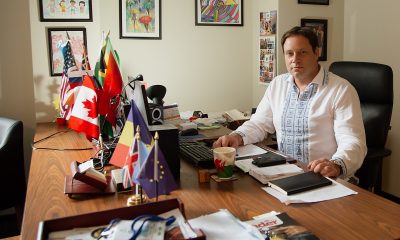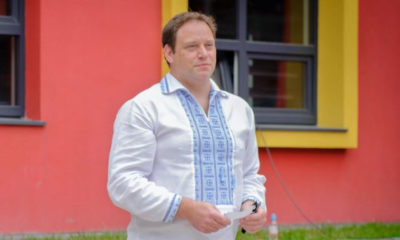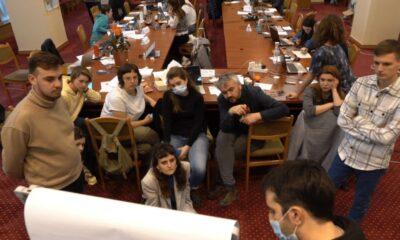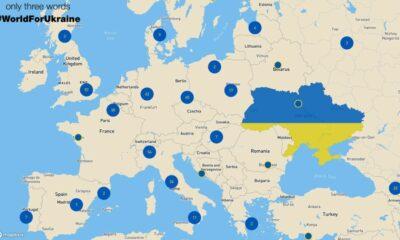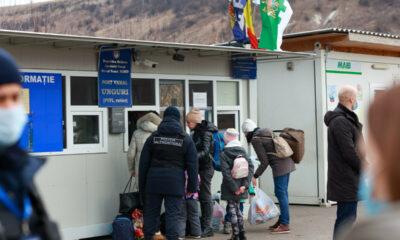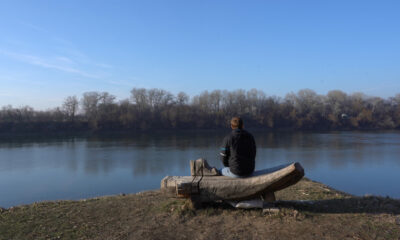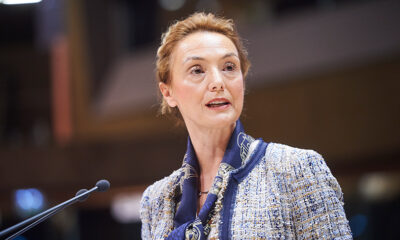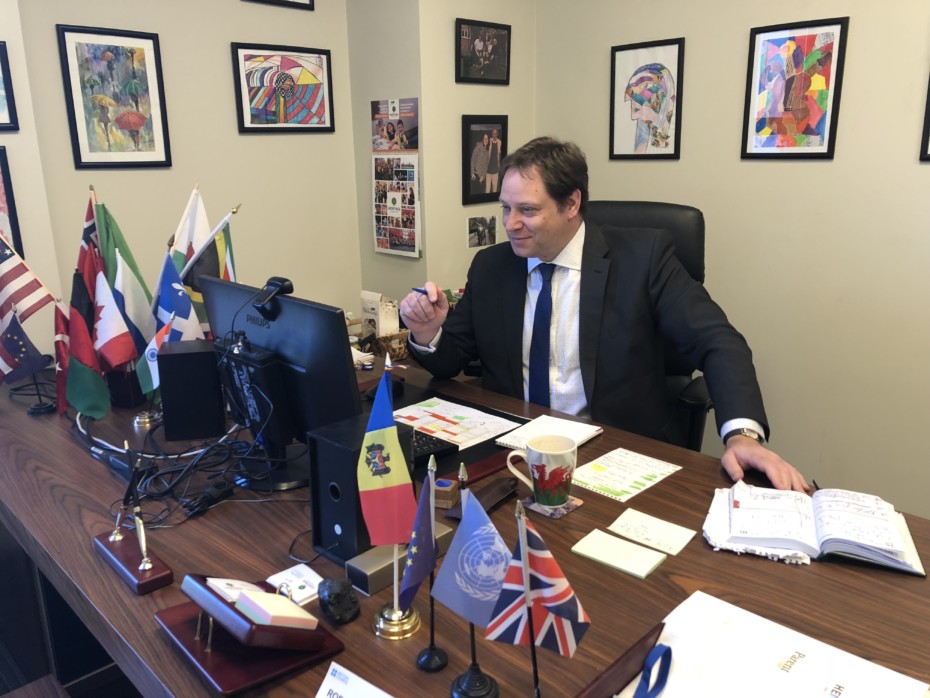
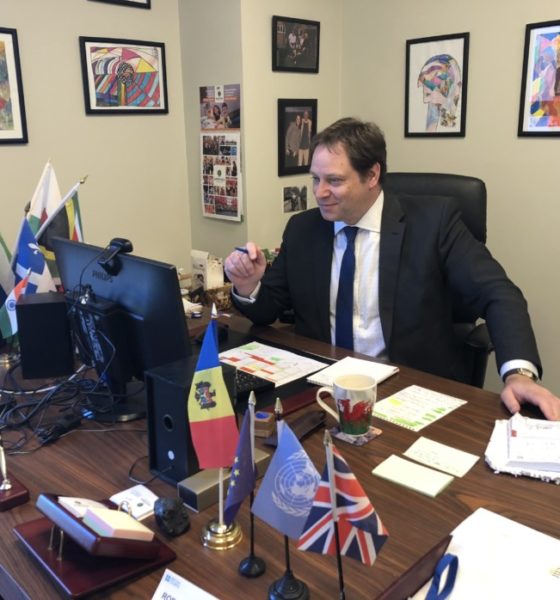
Education
Robert Ford, Director of Heritage International School: „We are working hard to make sure that we are back in September fully”
In its third year in Moldova, Heritage International School had to act quickly and firmly to make sure the educational process continued during the pandemic. Adaptability and communication were the two main values guiding the leadership of the institution towards a smooth transition and, with the help of a well trained team of international teachers, they managed to achieve the goal: not one day of classes was missed and students and teachers made the best out of the new situation. For the upcoming school year, the school is preparing, based on thorough research and documentation, to get the students back to school safely. We discussed these issues with Robert Ford, a global educator and the director of Heritage International School in Moldova.
What was the response of Heritage International School towards the pandemic? I’ve heard that your students haven’t missed even a day of school, is that true?
It is true. I am so proud of the response of our whole community towards this. Nobody could have prepared for this, nobody in any organizations has ever faced being potentially closed down for months with uncertainty. And I think it underlines the commitment of Heritage International School to making sure that we continue to deliver the quality education we always had and put the students at the heart of every decision we make. So when we saw what’s coming, at the end of February-beginning of March, we swiftly moved to a Distance Learning Plan. We already had the capabilities, we had a digital platform in school.
Wellbeing and mental health of everybody and the students, in particular, was really important. But I’ve got to pay tribute to the remarkable team of educators and support staff at Heritage International School, for the full sight, the willingness, and the skills they had, nobody wanted to leave this as “let’s wait and see”. Doing nothing wasn’t an option for us.
Could we go a bit more into details regarding your Distance Learning Plan (DLP)?
We had 2 days to put the DLP together and I still can’t believe that we did it in such a short space of time. The platform we used was Google Classroom, we have been using it in school anyway. We trained our teachers on how to use it. And obviously that process continued.
We hold a regular teaching and learning training session in the morning every Wednesday for all of our teachers, we go through all sorts of topics. So their mindsets are really good in terms of adaptability. And I think it was adaptability that was really important. We did a lot of work with the students as well. They were really, really keen to make sure their learning continues, so everybody had a buy in.
I know that in some schools around the world it was more the case of asynchronous learning, a sort of homework style package and we knew that for us that wouldn’t work. Our students needed daily meaningful routines in education. My own daughters were on the Distance Learning Plan, so I know how valuable that is from a parent’s point of view.
I would greet students every Monday, I would stand in the front of the school and say good morning and goodbye in a recording as a part of my role as a director every day. I missed meeting the kids physically. I was also learning as well. We had the last day of school online, this was a really important event for people, marking a sort of rite of passage. We held the event online for like three hours and we had the most amazing music, and speeches, and even at the end children rang the bells together simultaneously around the screens while people were in their homes.
We explained everything to parents, for us a good strategy is 10% action and 90% communication. So we knew that keeping all our communities together is essential. I mean, we have got three languages (English, Romanian and Russian) and we have got 20 nationalities, keeping them all together through this was really important.
The Minister of Education has proposed several scenarios for going back to school next year, so I wanted to know what is Heritage planning for the upcoming school year. What should parents and students expect?
We were working on this question in May, before the schools would even close, because we need to give certainty to our community. But we’ve seen our societies working again, we can’t just be in inertia forever, we can’t just be at home atrophying.
The world is already working under lockdown conditions, airports operating with physical distancing, and more hand washing, and people wearing masks. We have seen it in our supermarkets, on buses, so don’t think it’s a huge leap of imagination to see what a school would look like when the students return. So we shared with the Ministry, at the end of June, our proposals for how we could physically return. We also shared it with our community, of course. And for us, at Heritage, with good communication, we can fully and safely return to school on the 1st of September, to have all our students back in classrooms.
We looked at what WHO (World Health Organization) would advise and they have put together some really good advice for schools around the world. Now we are working hard to make sure that we are back in September fully with a prepared plan.
We are putting together webinars and videos. For example, our teachers are working around the school literally with a camera to show children: this is where you come in, this is where you wash your hands, you don’t bring a lot of objects to school, because that would mean more wiping for disinfection and we want to cut down the risks of transmission. There would be temperature checks. If there are any symptoms there is an isolation area next to the medical room which has a separate entrance and a bathroom, so we can get children or adults into isolation as soon as possible. These are all things we are taking into consideration.
At the heart of all of this is the trust and confidence of the families, and they are really important to us.
How do you think the events happening now and the decisions taken now will influence your students short term and in 20 years time?
I think our students are global citizens, they are going forward, into an interconnected world. Because COVID-19 has demonstrated there are no national frontiers: rich, poor, European, Asian, American, it will affect us all. And that common humanity and those common solutions are really what we need to look at in order to thrive in the future. From that point of view I think this crisis had positive effects as well.
And as an outward-facing school we know our students will be mobile, they will work, they will study, they will be tourists, they will have friendships, they will have all sorts of opportunities and ideas. What the world can’t ever go back to is a closed world, it can’t go back to closed societies. And even though this crisis made us isolate, in fact, if anything, it made us more interconnected.
Heritage is the only Cambridge School in Moldova. Could you explain what that means and why it is important?
When Heritage was set up, it deliberately wanted the international curriculum to be an intrinsic part of its education. Cambridge International Assessment is used by about 30% of international schools around the world and it is based on the British model of GCSE (General Certificate of Secondary Education), IGCSE (International General Certificate of Secondary Education) at 16 years old and A-levels at 18, which are qualifications like a diploma, baccalaureate, that allows you into the university. It is recognized by every university, every country, especially the Ivy League, Oxford, Cambridge. The reason why Heritage wanted this international curriculum is because it gives you more sorts of skills, basis, linked to qualification, linked to knowledge. It looks at education from a global perspective, it’s not abstract. It wants real-time learning linked to real-world cases.
Heritage is an innovative school. It wants to do something very different in traditional education, it wants to offer an alternative, which is based on global international standards.
We have already had several European and British, and American universities representatives coming and talking to our students. For us it is, again, not an abstract thing, we are leading them on to the next step of their futures.
Heritage has a very strong commitment to English language as well as multiculturalism. How does that work in a country like Moldova?
Having English in our school as a lingua franca allows the students to have that greater global access than they would in a normal school. The director is English, we also have Americans, an Australian, we have people from India, people from Canada. There are teachers from around the world, and that’s really important as well. And all of this helps with having a global perspective and listening, and hearing different stories.
We have many projects from eTwinning to British Council, to American House, to Global School Alliance. For us, it is natural to have partnerships and networks around the world. Our curriculum is different, our approach to learning is different. We see learning in a very different way.
We learn about wonderful Moldovan traditions, Romanian, Russian, American. It’s such a wonderful atmosphere. It’s why I have always worked in international education. It allowed me to think about my own identity. I am sort of Welsh, and English and British, and European. But at the same time, as you can see, I am really proud about my adoptive country of Moldova.
So, for parents and students interested in achieving an education in Heritage International School, what should they do next?
We have very extensive social media. Have a look at what we are doing, see us on Facebook, Twitter, Instagram, our website has all our contacts there.
Even in this crisis, we can talk. We have been speaking throughout this summer to families that want to join us, from international families to local families, who want the certainty, the values and the mission that Heritage has to offer. We are open every day, the school is never closed. We are always available and we will arrange to talk to them and if they are in Moldova right now they can come and visit the school with the safe physical distancing and following all the regulations. As I was saying earlier, adaptability was key for us, so we also created safe and comfortable ways for people to find out more about us online. We have created the first virtual open house, a 360 degree tour recorded at the end of May, to show the campus.
[youtube id=”oGSV2ZX6x-8″ start=”0″]I know everyone lives with a lot of uncertainty regarding what’s next right now, but how do you envision the future of Heritage International School?
For Heritage International School the future starts here, the future is already happening, this is the reality. I am really looking forward to getting back to Moldova, my second home, and to start the new school year. We will have a great fourth year. It’s incredible to think it’s only our fourth year, but we have got the development of our lyceum, the onward development of our Cambridge Curriculum, more opportunities to develop global citizens and student leadership. We have a real commitment to make our students good, socially responsible leaders in our society, in our communities.
The school is growing all the time, we are really pleased about the increase in student numbers. People want to come to Heritage and that is really positive. We have some incredible teachers coming to us from around the world and that is a real privilege. I look forward to getting the kids physically back in school and moving ourselves forward. I am going back to a Chinese proverb: “If you plan for one year, plant rice, but if you plan for 100 years, educate children”, and I think that’s really where Moldova and Heritage come together.
Education
Romanian language schools in the Transnistrian region – a delayed and unresolved problem

Education institutions in the Transnistrian region resumed their activities on September 1, just as the schools throughout the entire territory of the Republic of Moldova. Once a new academic year began, the old and postponed for 30 years problems of the region came to light again.
There are 8 schools with teaching in Romanian on the Transnistrian territory (5 high schools, 2 secondary schools and a boarding school) that have been persecuted, limited and discriminated since the 90s, when Romanian was declared the official language of the independent Republic of Moldova. Nowadays, the education institutions “face numerous pressures and intimidations from the Tiraspol administration,” Promo-LEX Association alerted.
Such issues as lack of own buildings, the existing ones being not adapted to the education process, the risk of students’ enlisting in the region’s army, and challenges to ensure the free movement of persons and goods are some of the main problems encountered by the Transnistrian schools that teach in Romanian.
Administration of such schools told about the challenges with fighting for the rented space at the beginning of every academic year. Even though buildings get prepared for the education process, rents are paid from the Moldovan Government budget, being ready to receive students in time, Tiraspol authorities still create artificial troubles that put the schools’ activity on hold. For example, a compulsory registration on a Transnistrian online platform is required – an operation that would allow the institutions from Transnistria to bring goods from the right bank of the Dniester or refuel the school buses at gas station located outside the region.
“We are like an exchange currency,” claimed Raisa Padureanu, Deputy Director of Education at “Lucian Blaga” High School in Tiraspol, referring to every conflict situation between Chisinau and Tiraspol. The education institution operates using the study programs developed by the Ministry of Education in Chisinau in order to facilitate the diplomas‘ acknowledgement by the Moldovan authorities. That, on the other hand, complicates the registration process on Transnistrian platforms.
This September, the Transnistrian militia supervised the gatherings on the occasion of celebrating the beginning of the academic year at 2 schools. Moreover, one case of prohibiting to sing the anthem of the Republic of Moldova and to hoist the state flag was registered.
Some students have to go long distances in order to arrive at school, busses not being provided. Promo-LEX Association reported the problem as violation of the right to free movement and education of children on the left bank of the Dniester.
In such cases, the Bureau for Reintegration Policies and the OSCE representatives are contacted for help, informing the mediators and observers of the 5 + 2 negotiation format as well. Officials’ intervention unlocks the educational process for the moment. The issue remains unsolved in the long rung though, as Tiraspol authorities insist on imposing their own rules, remaining a separate region with a unsettled status.
See also: Good laws, bad implementation? What stands in the way of vaccinating education system employees?
Photo: moldova.org
Education
Good laws, bad implementation? What stands in the way of vaccinating education system employees?

The National Extraordinary Public Health Commission (NEPHC) approved, on August 23, new public health measures concerning the activity of education institutions, which shall open their doors starting September 1. Students of primary, secondary, high schools, universities, and vocational schools are supposed to physically attend their classes. All teachers, students and auxiliary staff must wear masks, keep social distance, classrooms would have to be cleaned, as well as rules regarding shorter classes and training plans are imposed.
Given the unfavourable evolution of the COVID-19 pandemic and in order to ensure conducting the educational process in full safety, the Commission recommended reaching the vaccination rate among employees of at least 95% in each education institution, until October 1, 2021. Such a measure is especially enforced when taking into consideration that communities in the education system are mostly formed of children – a group that is not protected by immunization against COVID-19, the NEPHC said.
By the moment the vaccination rate would reach 95%, authorities aimed at controlling the infection rate through introducing compulsory testing for COVID-19 every 14 days, which are supposed to be paid by school employees themselves, that also representing an additional incentive for those who are not yet vaccinated to do so, as vaccinated persons are exempted from complying to this measure.
The NEPHC measures have aroused a wave of discontent in the society. Members of the Education and Science Trade Unions Association transmitted teachers’ “perplexity and indignation about the obligation to get vaccinated and the recommendation to pay from their own sources for COVID-19 tests.”
Mayor of the capital city, Ion Ceban, claimed that City Hall would not comply to the NEPHC decision, saying that a vaccination rate of over 70% has been reached in Chisinau. “The decision of the Commission remains to be null on the territory of Chisinau municipality,” Ceban declared. Moreover, the mayor came up with his own plan of managing the Chisinau healthcare system under pandemic conditions, claiming that it could be applied by the Ministry of Health at national level. He also stated that the Executive has not worked enough with the City Hall to fight the pandemic.
On the other hand, Minister of Health, Ala Nemerenco, replied that “the Commission’s decisions can be cancelled only by the Commission and no mayor’s office or even local office of the NEPHC can declare them non-binding.” The Minister announced that the measures are dictated by the intention to maintain the activity of schools with the physical attendance of students as much as the epidemiological situation allows it, and to have a safe school environment for children.
“City halls, as founders of educational institutions, could find ways to organize and fund these tests. This is exactly what the unions could do as well, instead of generating conflicts and dividing people when in fact it is a simple epidemiological rule that comes to stop the transmission of the virus, to ensure the protection of children, teachers, but also to save the lives of many. […] Those who will cancel the NEPHC decisions will fully assume responsibility for the epidemiological situation in schools, the return of schools to online training and for the health of children and teachers.”
An idea on how to manage the education system crisis was promoted by members of the Dignity and Truth Platform Party. They came up with an alternative for teachers who were not immunized yet: to benefit from antigen tests donated by the Republic of Moldova by external partners. The DTPP representatives suggested that this process should take several months, whereas additional information campaigns on the importance of vaccination should be held in educational institutions.
The Romanian Government took a decision, on August 26, to send 100 000 antigen tests for COVID-19 detection to the Republic of Moldova.
Last year’s experiences showed that the education system of the Republic of Moldova is not readyyet to function online for a long period. At the same time, conducting of the education process with the attendance of 100% students and teachers is very risky without taking additional measures to combat the spread of the virus. This is the case when compromise solutions are crucial and need to be quickly implemented.
See also: 7 ways of re-opening schools in Moldova – the present-day problems of the education system
Photo: Moldova.org
Education
Why do we need a radical feminist movement in Moldova?
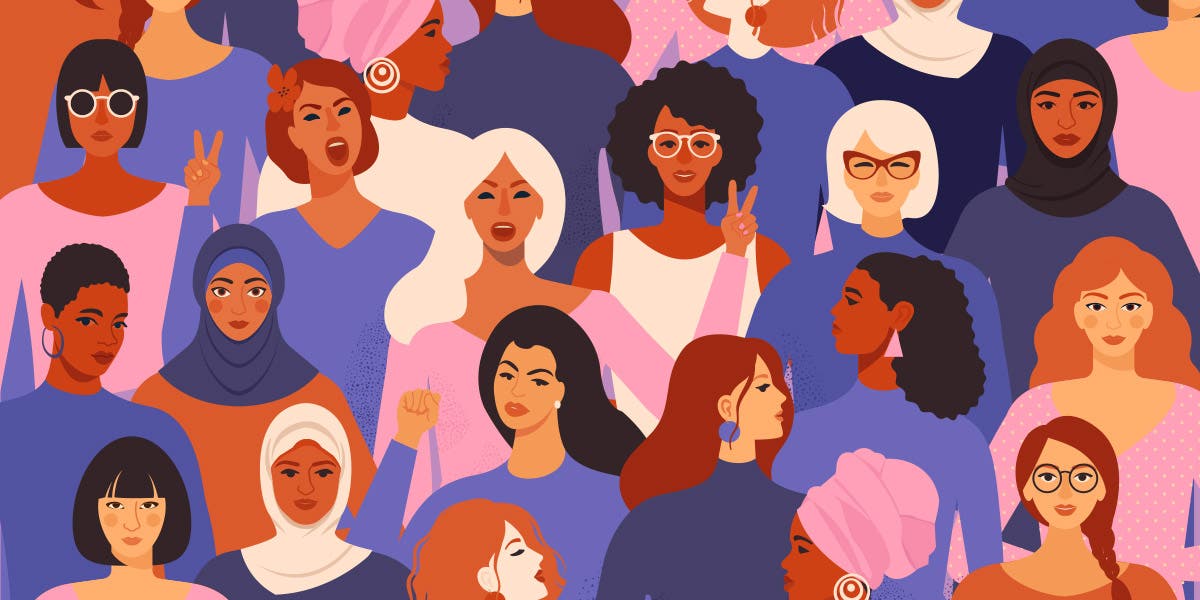
In choosing the title for this article, I am at the same time afraid I lost part of my readership and hopeful that maybe I managed to provoke some to click and skim through. “Feminism” is a scary word in our society, but regardless of your gender identity, feminism concerns you.
Everyone is already over 8th of March and already looking forward to the next red day in the calendar. But I am still processing the amalgam of pictures and messages shared on the 8th of March. Only a few years back this day was a normality in my everyday life – the day we are grateful to the women in our lives and our mothers for their unconditional love, patience and “quiet suffering” – which in itself should be a point of outcry not celebration.
As a child I never really questioned this day. In fact, I was even feeling a little guilty. How come women have a whole day dedicated to themselves, a national holiday, but men don’t? What an injustice!
Today, thankfully, I feel differently. The multitude of flowers, sweet messages, congratulations left a bitter taste in my mouth. How come every Moldovan knows about 8th of March, but only so few understand the meaning of this day?
There is, at the same time, a wave of influencers and so-called coaching gurus promoting #girlboss and #leanin feminisms, a mainstream brand of woman empowerment that is very much fitting into the capitalist economic order: As long as my t-shirt says “female empowerment” I don’t care about the woman in an Asian sweatshop who made it for pennies.
In this article, I again put on my political glasses and aim to dismantle the romanticism surrounding mainstream feminism that seems to have pierced through our society and to reflect on the need for radical feminism in our own Moldovan context.
What is feminism?
As Chimamanda Ngozi Adichie mentions in her book “We Should All be Feminists”, the word “feminist” and the idea of feminism is limited by stereotypes and is loaded with a lot of negative baggage.
Some think feminists are sad women who can’t find husbands or women who hate men. Others think feminists are women who don’t take care of themselves, who don’t wear makeup nor high heels. Or that they are women who always have to be in charge and therefore are bossy and bitchy. The narrative differs, but the essence stays the same – a feminist is often portrayed as a woman, followed by a negative description. This negativity stems from gender expectations, that boys should be one way – tough, rational, powerful – and girls should be another way – polite, quiet, caring. And when we transcend these gender expectations, society raises its whip. Gender expectations are cruel for both girls and boys, for when boys are taught to suppress their emotions and girls to be submissive – everyone suffers.
There are other, even more worrying patterns in Moldovan public discourse, where people with a lot of reach call feminism and gender related issues “Western values”, alien to our culture, region and history. For politicians and other public figures making such claims, we shall point out to a historical fact. The women’s movement in our region started in czarist Russia and kickstarted the February Revolution. On the 8th of March 1917, female textile workers in Petrograd demonstrated and demanded the end of the czarist regime, protested against the food shortages and the end of World War I.
Internationally, the movement was permeated with socialist ideology. In 1857 female garment workers in New York took to the streets to demand political emancipation. In Europe, the movement took a similar stance.
“Socialist women of all countries, fight in unity with the Socialist International against the war. The modern war is mass destruction and mass killing. But war is only the expansion of the mass killing that capitalism is perpetrating every hour of every day against the proletariat. Year after year, hundreds of thousands of victims fall on the battlefield of labour in the capitalist developed nations – more victims than in any war. Women are a growing number of these victims. War is only the maddest form of mass exploitation through capitalism.” declared Clara Zetkin, a German communist activist and advocate for women’s rights, in 1912 at the first International Socialist Women’s Conference.
The 8th of March, the International Women’s Day was marked by a revolutionary spirit. Feminism was perceived and intended as a radical tool for fighting back against structural violence and injustice. The word radical means addressing at the root. The women who fought for political emancipation were not just fighting for women to gain the same economic and political rights as men. They were fighting against an economic and political system based on oppression and exploitation that affected both men and women.
What we celebrate today however resembles nothing of the radicality of the incipient demonstrations. Today, we are likely to experience and see a different brand of feminism, one compatible with the corporate capitalist order.
Since the 1970s a new brand of feminism has emerged, one emphasizing women as self-sufficient individuals. It focused on women’s right to be independent financially, the right to develop one’s skills and abilities, the right to control fertility, the right to participate in the market economy.
This coincided with the restructuring of the global economy to a neoliberal order looking to cut costs (by paying women less) and revive the pace of growth:
- De-industrialization of developed economies and the move of manufacturing to the de-unionized South with cheap (women) labor
- The financialization of the global economy and the rise in service sector jobs
- Shrinking of the public sector (privatization of healthcare, education, water, electricity)
- Reduction of costs through automation and immigrant labor
This movement undeniably advanced the feminist agenda. Women could get out of violent, unsatisfactory marriages, women could pursue an educational path and a career previously believed to be suitable only for men. But at the same time, it individualized feminism. It was relevant for only a minority of women and overall faded the initial radicality of the movement. It became the problem of individual women to speak up, ask for raises, tell off misogynistic men and dream bigger. Women can be CEOs, and doctors and chiefs of state. While this is indeed a big step forward, it is essential to point out that this progress is relevant only for women who are privileged in the first place.
Getting more women in positions of power does not solve the many struggles of poor, immigrant, transgender, working class women, except making women part of propagating a system of oppression and exploitation. As Angela Davis, a political activist, philosopher and academic asks “if standards of feminism are created by those who have already ascended within the hierarchy and need the last climb to the top, how is this relevant to the women at the bottom?”
Let’s try a simple mental exercise – would having a woman head Amazon eliminate the company’s inhuman conditions in its distribution centers? Would having a woman head Nike eliminate the exploitative practices happening in garment factories in Asia? Would a woman president abolish the military industrial complex?
NO! A woman who aims to change the system rarely gets to these positions of power.
This is why the initial feminist movements were addressing the system, the injustices inherent in the economic, social and political systems. Inclusion and diversity are not enough. Fighting for only inclusion and diversity is encouraging a form of unthreatening feminism that does not change the status quo in the big picture.
And this is why we need to bring back the spirit of radicality that working class women had in 1917 and that empowered oppressed women all over the world who fought against patriarchal structures that continue advancing gender based roles and tolerate gender based violence.
Bringing back radicality to the feminist movement
In our own Moldovan society, there is a very stark class divide between women who can pursue the careers they desire and the women stuck at the bottom who perform the service jobs that make it possible for the 0.1% of women to “follow their dreams”. Unfortunately, this issue is not brought up by any political voice.
We need to look beyond the individual acts of charity used as political tactics and demand real structural changes, so that poor families wouldn’t have to depend on sporadic donations from elites. We need to fight against an economic system that drives women out of our own economy and pushes them into a precarious informal economy abroad.
We need to strengthen the public sector so that we, as a collective society, are able to create a secure safety net for the families and individuals that need it the most.
Grace Chang, the author of Disposable Domestics, documented the precarious lives of immigrant women in the US and shows how economic and social policies target specifically these vulnerable groups. One Filipina nurse working in the US whom she interviews says “we take care of everybody else’s weaker members of society, while we let our own society go to hell”. This example is not unique to the US context. We have our own share of women who migrate abroad leaving their kids behind. We have our own share of women who take care of Europe’s elderly in exploitative conditions for pennies. We should be able to provide opportunities for these women at home.
Hester Eisenstein, professor of Sociology at Queens College says that “massive unemployment resulting from the shrinking (or in our case from the inefficiency and underinvestment) of the public sector forces families to rely on their own resources”. Women adopt new strategies of survival – selling handicrafts in local markets, selling the little they have in their gardens on the streets, selling their labor in developed countries doing jobs in elderly care work under exploitative conditions, or selling themselves into prostitution.
A feminist movement in our Moldovan context should undoubtedly adopt a socialist character – fighting for economic and social justice for marginalized people domestically and for the exploited Moldovan immigrants abroad. We need to recognize and acknowledge that our entire economy is dependent on feminized labor that goes unnoticed in mainstream economics. Domestic work (caring for children, elders, and homes) – characterized by low wages, isolation, lack of job security, lack of access to basic benefits and services, lack of control over working hours – is the work that makes all other work possible.
And finally, a feminist movement in our context should not have a gender. Because class divide, precarious work, economic insecurity, migration, poverty concerns all of us.
And I would like to end with a message from Angela Davis that best consolidates the message of this essay:
“I think that this is an era where we have to encourage that sense of community particularly at a time when neoliberalism attempts to force people to think of themselves only in individual terms and not in collective terms. It is in collectivities that we find reservoirs of hope and optimism.”
Catalina Catana hopped countries every few years, playing entrepreneurship in various corners of the world while growing a silent passion for social sciences and progressive economics. A few years in the private sector were enough to convince her to change her direction. She is researching and writes about global issues related to development, inequality, and social justice.


